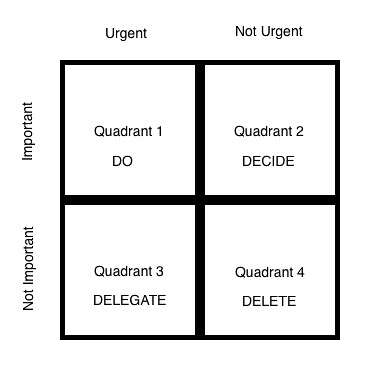In high-growth industries, leaders constantly face a deluge of tasks, each of which seems to demand immediate attention. In these moments, it’s important to employ a process of prioritization – a tool that may seem humble, but can unlock incredible productivity. It may feel difficult to sort through your tasks in the moments when they feel so staggering, but when you take a strategic approach, you can accomplish more than just ticking off items on a list. Which is to say that when you prioritize, you can make meaningful progress toward your goals.
One of the most effective frameworks I recommend is the Eisenhower Matrix; here’s an illustration below.

Here’s the key: the matrix should be treated as a dynamic tool, not a one-time exercise. In a startup, priorities shift rapidly, so regular reassessment is crucial. Effective prioritization demands both agility and a team culture that fosters shared ownership of priorities across roles.
Why Context, Flexibility, and Autonomy Are Essential for Prioritization
Effective prioritization goes beyond sorting tasks into “urgent” and “important” categories. It requires an understanding of both the big picture and how goals might evolve over time. Before making prioritization decisions, ask yourself: Do I have all the context I need to make the right calls? This isn’t just about gathering data; it’s about building strong communication channels with your CEO and cross-functional teams. Regular check-ins ensure that everyone has the most current information needed to adapt priorities as objectives shift.
Another key element is flexibility. Especially in startups, priorities are dynamic, and an agile approach to prioritization enables leaders and teams to adapt as company goals evolve. Treating the Eisenhower Matrix as a living document—one that you revisit frequently—ensures you’re always directing your time and energy toward what matters most. It’s about developing the habit of regularly reevaluating what’s on your plate and adjusting as necessary.
To make this process truly effective, empower your team to prioritize autonomously. Give them the tools and confidence to make prioritization decisions within their roles. For example, if you’re a marketing leader, give your team a broad directive – e.g. “increase brand awareness among enterprise customers by 25%” – along with any budget constraints. Then ask them to rank activities, such as social ads, webinars, and brand partnerships, by feasibility and projected ROI. That way, they can pursue the broader goals by making prioritization decisios on their own.
This builds ownership and accountability and accelerates decision-making. When team members feel trusted to evaluate and adjust their priorities to align with the company’s goals, leadership is free to focus on high-level strategy, while the entire team is empowered to work in sync.
Avoiding the “Silo Trap” with Transparent Collaboration
One common pitfall in prioritization is working in isolation. While it might seem efficient to tackle priorities independently, communication and transparency actually supercharge prioritization. s. Regular check-ins with leaders, peers, and cross-functional teams can reveal where priorities overlap or even conflict. By eliminating roadblocks that may arise as a result, open communication reduces redundancy, ensuring everyone is focused on unified goals.
Working together rather than in silos keeps the entire company moving in the right direction. Regular team updates and cross-departmental meetings are great ways to maintain this alignment, ensuring that no matter how dynamic the environment, everyone understands the bigger picture and how they contribute to it.
Prioritization as an Extension of Your Company’s Vision and Values
When faced with an overwhelming number of tasks, it’s helpful to remember that effective prioritization is about more than just completing what’s in front of you. True prioritization drives you toward more truly adhering to your company’s mission and values. Anchoring tasks in the company’s purpose brings clarity, especially in resource-constrained environments.
In fast-paced industries, taking a moment to ask, Does this align with our core vision? can help filter out distractions and keep your team on track toward long-term, meaningful objectives. In startups, where resources are often stretched, using the company’s purpose as a guiding light helps prioritize time and energy effectively.
A Strategic Approach for Sustainable Success
So here’s the challenge: Take a fresh look at your current priorities this week. Are they aligned with your organization’s vision and values? If they aren’t, take the opportunity to reset and ensure your energy is focused where it matters most. After all, prioritization isn’t just about what you choose to do—it’s about what you decide to leave behind.

